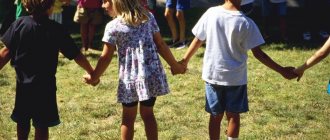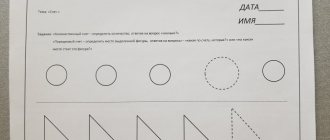“Games with rules - types, features of use in a group”
Traditionally, a game with rules appears in modern domestic pedagogy as a kind of antagonist of a plot game. Most practical teachers quite rightly believe that story-based play, or as it is often called, creative play, can take the form of a child’s free and independent activity. Another thing is playing with rules. This type of play is presented either as an ordered motor activity organized by an adult, during which children do not simply move randomly, but obey rules, the implementation of which is monitored by the teacher. Another popular form of games with rules in kindergarten is children playing with printed board games, such as dominoes, lotto and “goose”. In all of these games, the main attention of all participants, children and adults, is paid to the content of the game, its plot basis.
Games with rules represent a very extensive layer of activity for a preschool child. It is generally accepted that play with rules is of great importance for the physical, sensory and mental development of children. But, as a number of modern scientists note, the main developmental significance of a game with rules is associated with its specific characteristics. First of all, this is the development of independent normative regulation of behavior in children. If there is a rule (norm) that is mandatory for all participants, there is a need to monitor their implementation. In children, in their independent activities, conditions are created and the need arises for the implementation of such an important moral principle as justice.
A game with rules is characterized by competitive relationships between participants. The child has the opportunity to independently distinguish himself from other children, in accordance with simple and understandable criteria. For the development of a child, the fact of not only winning, but also losing is important. The experience of failure in a game contributes to the emergence in the child’s character of very important qualities (perseverance, the ability to achieve a given task, etc.), which will be useful to him in later life.
The whole life of a preschooler is connected with play. Mastering the things around him, relationships between people, understanding the meanings that social life carries, the work and responsibilities of adults - he gets acquainted with all this while playing, imagining himself in the role of mom, dad, and so on.
During the preschool period, the basic volitional qualities of the individual begin to form: perseverance and perseverance, determination, quick decision-making and bold implementation of them; self-control, that is, lack of vehemence when a conflict arises, independence, responsibility and discipline. Preschool age is a unique period in a child’s life, in which the foundations of personality are laid, the arbitrariness of mental processes is developed, creativity, activity and initiative develop. All these important qualities are formed in the process of carrying out the preschooler’s leading activity - in play. The most important role in the development of older preschoolers is played by those qualities and mental processes that are associated with the child’s ability to carry out complex, detailed play activities, primarily role-playing games with a plot, with the distribution of roles and rules. One of these qualities is will. Features of the development of will in preschool childhood are: the formation of goal setting, the emergence of struggle and subordination of motives, the emergence of internal control in behavior, the development of the ability to exert volition, speech planning of activities, encouraging adults and peers to carry out their own plans, arbitrariness in the sphere of movements, actions, and also cognitive processes and communication with adults.
Examples of outdoor games
In the game “Homeless Hare,” children performed the movements of hares: they jumped onto the meadow, had fun, danced, waved their paws, and sang songs. One student was so busy doing the moves that she forgot about the fox and was very surprised and confused when she was left without a house. When playing the game again, we reminded her about the fox. She was very pleased when she managed to occupy the house. We developed the emotions of surprise, fear, anger, pity in the game “Geese and the Wolf” . In order to unite the children's team, we use group games (especially team games) to unite players with a common goal - victory in the competition. Team members will help each other quickly complete the task you set, and after the game the children will discuss their impressions and share their emotions for a long time. In the process of physical education of children of primary preschool age, outdoor play plays a leading role. Being one of the main means and methods of physical education, outdoor play allows you to effectively solve health-improving and educational tasks. It has a comprehensive impact on the physical development and health of the child. During the game, the motor activity of children causes an active state of the whole organism, enhances metabolic processes, and increases vitality. In the process of play activities, children develop moral and volitional qualities, develop cognitive powers, and gain experience in behavior and orientation in a group environment. An active game with rules is a conscious, active activity of a child, the goal of which is achieved by accurate and timely completion of tasks related to the rules that are mandatory for all players. According to the definition of P.F. Lesgaft, outdoor play is an exercise through which a child prepares for life. The exciting content and emotional intensity of the game encourage certain mental and physical efforts. Play can be a means of self-knowledge, entertainment, relaxation, and a means of physical and general education. Play is a very emotional activity, so it is of great value in educational work. Among the wide variety of games in the formation of a child’s diversified personality, outdoor games are given the most important place. The importance of outdoor games is great: they are both a means and a method of raising a child. Outdoor play as a means and as a method is characterized by a variety of effects on the child due to physical exercises included in the game in the form of motor tasks. In outdoor games, various movements are developed and improved in accordance with all their characteristics, the characteristics of children’s behavior and the manifestation of the necessary physical and moral qualities are directed. With the help of outdoor games, you can solve various problems of moral, mental and, of course, physical education. As Shapkova L.V. notes, “with hypokinesia (inactivity) in children, the activity of biochemical processes decreases, immunity to colds and infectious diseases weakens, the range of capabilities of the respiratory and cardiovascular systems narrows, the neuromuscular system weakens, various postural defects form, which leads to muscle hypotonia, decreased mobility of the chest in all its parts, general weakening of the body and decreased vitality. A characteristic consequence of these disorders in the functioning of various systems and organs is the deterioration of physical and psychomotor qualities: coordination, accuracy and speed of movements, speed of motor reaction, mobility and general performance.” Taking into account the age characteristics and physical fitness of those involved in outdoor games, they have a beneficial effect on the growth, development and strengthening of the musculoskeletal system, the muscular system, on the formation of correct posture in children, and also increase the functional activity of the body. Active motor activity of a playful nature and the positive emotions it evokes enhance all physiological processes in the body, improve the functioning of all organs and systems. A large number of movements activates breathing, blood circulation and metabolic processes. This in turn has a beneficial effect on mental activity. It has been proven that outdoor games improve the physical development of children, have a beneficial effect on the nervous system and improve health, because Almost every game involves running, jumping, throwing, balance exercises, etc. The game plays a big role in the formation of personality. During the game, memory and ideas are activated, thinking and imagination are developed. During the game, children act in accordance with the rules, which are mandatory for all participants. The rules regulate the behavior of the players and contribute to the development of mutual assistance, collectivism, honesty, and discipline. At the same time, the need to follow the rules, as well as overcome obstacles inevitable in the game, contributes to the development of strong-willed qualities - endurance, courage, determination, and the ability to cope with negative emotions. Children learn the meaning of the game, learn to act in accordance with the chosen role, creatively use existing motor skills, learn to analyze their actions and the actions of their comrades. Outdoor games are often accompanied by songs, poems, counting rhymes, and game starters. Such games replenish vocabulary and enrich children's speech. In outdoor games, the child has to decide for himself how to act in order to achieve the goal. Rapid and sometimes unexpected changes in conditions force us to look for more and more new ways to solve emerging problems. All this contributes to the development of independence, activity, initiative, creativity, and intelligence. Outdoor games are of great importance for moral education. Children learn to act in a team and obey common requirements. Outdoor play is collective in nature. The opinion of peers is known to have a great influence on the behavior of each player. In a collective outdoor game, each participant is clearly convinced of the benefits of common, friendly efforts aimed at overcoming obstacles and achieving a common goal. The main task of outdoor games is to strengthen the health of those involved and promote their proper physical development; promote the acquisition of vital motor skills and abilities and improvement in them; development of reaction, development of dexterity, knowledge of movement and new capabilities of the body. To implement the tasks, it is necessary to apply the following methods:
- Analysis of theoretical and scientific-methodological literature on the research topic;
- Pedagogical supervision;
- Questioning.
Theoretical analysis and synthesis of literature involves a search for literary sources, which was carried out in libraries, materials from magazines, collections of scientific papers, other scientific and scientific-methodological publications were analyzed, and Internet resources were also used. Many researchers recommend including outdoor games in physical education classes at preschool educational institutions and in children’s daily lives. The practical significance lies in the possibility of using the proposed outdoor games for physical development with children. Having mastered the general tasks of education, we apply them taking into account the individual characteristics of each child. To do this, we used medical examination data for all indicators in order to know which of the children had deviations from the norm of physical development. For the first time, work days analyzed the state of children's motor skills, as well as their overall level of development.
We outlined specific tasks for each child. Children who are timid and unsure of their movements need help in overcoming difficulties: lower the rope lower when jumping, place the basket closer when throwing a ball, support them for balance while walking, etc. But this must be done unnoticed so that the child’s self-esteem does not suffer. Children are easily excitable, overly active and also require attention; we often involve them in games that contribute to the development of inhibitory processes. We carefully analyze an unfamiliar game, mentally play it and only after that offer it to the children. We also first think through where it would be more appropriate to hold this or that game: indoors or on the site. Methodological literature usually recommends learning new games in class. But this can also be done during play hours, for example during a morning walk, when children and the teacher have enough time at their disposal. In order for this work to be systematic in each group, so that not a single child falls out of attention, outdoor games are included in the long-term plan of educational work, as well as in the plan of work for every day. It should be noted what outdoor games will be played with the whole group, what games he will organize with a group of children, and which he will offer to individual children. With the help of the game, the head of physical education or teacher carries out several tasks: strengthens, heals the children’s body, develops movements, causes joyful experiences, develops moral qualities, etc. When including a particular game in the plan, the teacher must know what qualities and skills he can develop and consolidate with its help: in one game running predominates, and in another - throwing, in one - endurance is required from children, and in another - agility, etc. When choosing a game, the teacher should keep in mind where he assumes to carry it out: indoors or on the site.
When selecting games, seasonality is also taken into account. In the summer, when children live among nature, you can use games such as “Catching Butterflies”, “Frogs and Heron”, etc. For winter time, you need to select games in which you can use specific winter materials - snow banks for jumping and balance, snowballs for throwing, etc. When planning games, the teacher should take into account the state of the group. In the case where the group is not sufficiently organized, it is better to initially conduct quieter games in a circle, games with singing, gradually moving on to games with scattered movement, or give simple games. When choosing a game, the teacher takes into account its place in the daily routine; for example, at the end of the day, when the children are already tired, he plays a quieter game. When selecting games for classes, in addition to general educational tasks, you have to especially take into account the hygienic side of each game - the degree of its load, the impact on physiological processes. The choice of game for a lesson depends on which part of the lesson it is included in. If the game is given in the first part of the lesson, it is introduced in order to organize a children's team, teach children to line up in a column, in pairs, in a circle, and place themselves on the playground. These are, for example, the games “Whose team will get together sooner”, “Find yourself a mate”, etc. In the second part of the lesson, a high mobility game is played. For the final part of the lesson, a game of medium or low mobility is selected, the goal of which is to bring the body to a relatively calm state. You can use the following games for this: “Who left?”, “Guess by the voice,” “Find where it’s hidden.” Most often, one, sometimes two games are given in a lesson. For example, one game is included in the second - the main part of the lesson (required), another - in the final one. Outdoor games, creating an atmosphere of joy, make the most effective complex solution to health, educational and educational problems. Active movements, determined by the content of the game, evoke positive emotions in children and enhance all physiological processes.
Children’s play activities objectively combine two very important factors: on the one hand, children are involved in practical activities, develop physically, and get used to acting independently; on the other hand, they receive moral and aesthetic satisfaction from this activity and deepen their knowledge of their environment. All this ultimately contributes to the education of the individual as a whole. Consequently, outdoor games are an effective means of diversified development.
Play is a creative process
According to A. Maslow, primary creativity is based on the unknowable; it can always be observed in a healthy child. This creativity is characteristic of those who can play, dream, laugh and be lazy, who can be spontaneously open to unconscious desires and impulses.
Intuition is “like a voice from heaven,” “the lord of revelation,” a new structure. This miraculous clarification, enlightenment, is a mechanism of intuition and is called insight, which translated from English and German (this term was introduced within the framework of Genetic Psychology) directly means perception.
Insight as a moment of remembrance can be seen in almost every narrative game, when it comes to finding substitute objects, actors for certain roles, integrating new circumstances into the plot, and the appearance of obstacles.
A game action is not born from an imaginary situation, but on the contrary, an operation with an action causes a game situation. Thus, the condition of play action contributes to the development of imagination and makes it necessary.
While the child is not playing, he does not imagine the game situation, and his imagination does not work.
Only during the game does the object seem to dissolve in its real properties and game meaning. Bisociation becomes the mechanism of imagination.
The term “bisociation” comes from A. Koestler, a researcher of the creative process who turned his attention to the subconscious. He emphasized the role of chance, the need to delay making decisions and think about the little things.
In the consciousness of being, as Freud said, “THE ONE,” there are no typical opposites, good and bad, right and wrong.
In this sphere of the psyche, opposites, right and wrong, are perceived as united, general, widespread.
This value-neutral perception promotes a new creative view of the world.
There are many known “techniques” of imagination. Among them is a combination of known elements in new combinations, which can be constantly observed in children's games.
It is also necessary to mention accentuation - emphasizing certain features of appearance (which is revealed). Exaggeration or arrogant understatement helps a child in a game or fairy tale to emphasize the game in some - or subjectively very important - sense. An accentuated reflection of a specific character or situation contributes to generalization and typification, since some features are simplified, discarded, and random features are discarded.
A child’s play activity is always of a generalized nature, since the motive is not determined by a specific phenomenon, but by the action itself, as a personal relationship.
In play, the child does not inherit or convey any specific characteristic traits; he is always typified.
Intuition stimulates the imagination, and the imagination perceives the development of creative thought.
Every active person has an ineradicable need to move from sensory perception of the world to rational thinking, the mechanism of which is mediation.
Thinking is the process of indirect cognition of things and phenomena, understanding the relationships and connections between them.
In all sensory phenomena, the child makes every effort to find the corresponding meaning, and his endless “how? Why? For what?" aimed at revealing the secrets of its existence.
New things that appear before a child every day are a mystery to him.
Thinking becomes a generalization of the result of observation, a generalization of indicative activity.
A person will not calm down until a mysterious, unknown phenomenon, disturbing by its very existence, acquires a certain meaning, which appears at the beginning of the game.
Play concentrates all developmental tendencies; through play, the child rises, as it were, above the ordinary level of his thinking and behavior.
"Nature" games
There are three that genetically replace each other and coexist throughout life: Play, study and work. They differ in the final result (product of activity), organization, and motivational characteristics.
Work is the main type of human activity. The end result of labor is the creation of a socially significant product. It could be a crop grown by a collective farmer, steel smelted by a steelmaker, a scientific discovery by a scientist, a lesson from a teacher.
The game does not produce a socially significant product. It is in the game that the formation of a person as a subject of activity begins, and this is a great and enduring value.
In the mental development of a child, play serves, first of all, as a means of coping with the world of adults. In it, the child assimilates the objective world of adults at the achieved level of mental development. The game situation includes substitutions (instead of people there is a doll), simplifications (for example, the external side of receiving guests is played out). Thus, in the game, reality is crudely imitated, which for the first time allows the child to become a subject of activity.
The game is freely organized and not regulated. No one can oblige a child to play board games from 10 to 11 o’clock, and after 11 o’clock to play mother-daughter games. The game can be organized, but he himself must accept this offer. This does not mean that the child should not have a strict daily routine. You should indicate the time of sleep, meals, walks, games and activities. But the content of the game, the child’s participation in it, and the end of the game are difficult to regulate. The child himself moves from one game to another.
Various types of activities complement each other, coexist, and interpenetrate. In kindergarten, a preschooler not only plays, but also learns to play and draw. The schoolboy plays with pleasure after school.
Game moments have been successfully introduced into the organization of the lesson. Lessons with elements of game situations captivate the student. The game is an imaginary journey through a map of our country or a map of the world in geography lessons, when students talk about what they “see” based on their imagination. Students enjoy taking on playful roles - in foreign language classes: teacher, guide, salesperson - in the role of active language acquisition.
An employee not only works, he also studies (at night school, technical school, college, or engages in self-education). He can play chess and participate in other sports games.
Although activities do not exist in isolation, they have different meanings at different stages of a person's life. Before a child enters school, the leading activity is play.
When we analyze play as an activity, we must first analyze its nature. In foreign psychological literature, theories of play are widely used, according to which a child’s play releases the innate biological need for activity, which is inherent in both animals and people. They try to connect the development of children's play with the corresponding stages in the development of human society. Interest in playing in the sand, digging holes, stages of growing bread, playing with animals - animal husbandry, etc.
Games according to rules are widespread in the lives of schoolchildren and adults. By playing sports, solving crosswords and other games that require mental stress, a person switches to another type of activity, increases mental and physical strength and receives emotional release.
Being the main activity of preschoolers, play does not exclude other activities. At the age of three or four years, the child is introduced to self-care. He must wash himself, get dressed, put away his toys. At 5-6 years old, the child’s responsibilities include caring for house plants, helping elders clean the room, etc. In kindergarten, children are happy to be on duty in the dining room, in the living corner and in the playroom.




